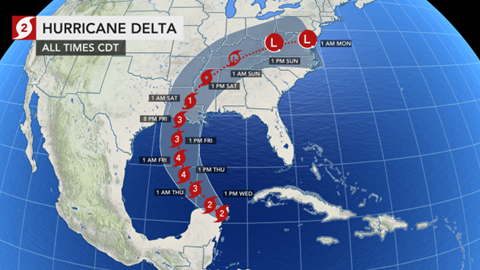The storm-weary Gulf Coast, an area still reeling from back-to-back blows from devastating Hurricane Laura and more recently Sally, is bracing for yet another strike, this time a potentially disastrous one from Hurricane Delta. The formidable hurricane crashed onshore in Mexico early Wednesday morning, cutting power and causing damage along its path, but losing wind intensity as it moved over land. Forecasters warned that the hurricane is expected to regain strength and return to major hurricane status as it emerges over the warm waters of the southern Gulf of Mexico and begins barreling toward the U.S. coast.
Delta weakened overnight as it tracked closer to the northeastern part of the Yucatan Peninsula, eventually making landfall in Mexico around 5:30 a.m. CDT Wednesday near the town of Puerto Morelos, south of Cancun along the Riviera Maya. At the time of landfall, Delta was a strong Category 2 storm with maximum sustained winds of 110 mph, just 1 mph below major hurricane strength.
Maximum sustained winds had weakened to 105 mph by 10:00 a.m. CDT Wednesday as the storm raced northwestward across the Yucatan Peninsula, unleashing life-threatening storm surge and strong winds.

While the water is warm over the southern Gulf of Mexico, it is not quite as warm as that of the northwestern Caribbean. However, the water is warm enough to allow re-strengthening and perhaps rapid re-strengthening for a time. Thus, forecasters and officials alike say Delta should be considered a dangerous threat to the U.S.
“As Delta approaches the central Gulf Coast, it will start to encounter increasing wind shear and slightly cooler water, but the forward speed of Delta and the degree of shear it encounters will determine its wind strength at landfall Friday evening,” Kottlowski explained.
Wind shear is the increase in wind speed with altitude as well as the sudden change in wind direction from one location to another. Wind shear and changes in the structure of the eye are some of the main challenges in forecasting the overall strength of hurricanes.
Delta is forecast to take a fairly steady west-northwest path into Thursday. Then, from Thursday to Friday, the hurricane is projected to begin a curved path to the north over the west-central Gulf. As the storm approaches the Louisiana coast late Friday, it may begin to turn more to the northeast.

Conditions are expected to deteriorate from Thursday afternoon to Friday afternoon along the upper Gulf Coast of the U.S. even well ahead of landfall and well away from the point of landfall.
“Delta’s outer wind field will remain very strong and can grow in size over the Gulf of Mexico,” Kottlowski explained.
Satellite images on Wednesday showed that the shield of clouds from Delta was growing and beginning to cover much of the Gulf of Mexico. Just 24 hours prior, the hurricane was extremely compact over the northwestern Caribbean – and hurricane-force winds extended only 25 miles out from the storm’s center on Tuesday.
“Regardless of a loss in wind intensity near the core, surge and wind impacts will still be potentially devastating along and near where the hurricane makes landfall along the central Gulf coast from late Friday to early Saturday,” Kottlowski said.
Given Delta’s current forecast track and strength, AccuWeather StormMax™ winds of 140 mph are forecast for part of southern Louisiana on Friday evening. However, this could trend higher depending on how much the storm strengthens over the central Gulf.
As is often the case with hurricanes forecast to make landfall, exact track and strength will determine the severity of impact in the region.
A fast forward motion may prevent Delta from weakening quickly prior to or upon landfall. The risk of damaging winds can extend well inland and result in not only a significant amount of power outages but also property damage. Trees may block streets and secondary roads. The power could be out for many days in some of the hardest-hit communities.
During Wednesday, Thursday and Friday, winds and seas will build over the Gulf of Mexico, especially in the central part of the Gulf. However, dangerous surf conditions are likely to develop throughout the Gulf of Mexico at midweek and remain dangerous with frequent and strong rip currents from Florida to Louisiana and Texas into the start of the weekend.
Even though the eyewall containing Delta’s strongest winds may avoid the greatest concentration of petroleum rigs in the western Gulf of Mexico, operations of these rigs may be suspended for a few days. Some rigs off the Louisiana coastline have already been shut down ahead of the storm. The projected path of Delta and its high winds could impact oil refining operations in portions of southern Louisiana. There are multiple refineries along the Mississippi River, just west of New Orleans.
Wave action well ahead of the storm will begin to cause overwash and coastal flooding prior to Friday from part of eastern Texas to Florida. Near and just east of where the storm makes landfall, most likely in south-central Louisiana, a major and potentially life-threatening storm surge can occur. Any shift in the storm track could cause the area of greatest storm surge to shift correspondingly.
“It is possible the storm surge could be greater from Delta than from Laura, which was estimated to be 17.5 feet,” Kottlowski added.
Delta’s fast pace should prevent a repeat of staggering rainfall amounts and flooding from Harvey in 2017 or a lesser extent from Marco, Sally and Beta this year.
State and local agencies were preparing in Louisiana, a state expected to endure its fourth direct landfall from a storm this season with Delta. Gov. John Bel Edwards began urging residents to prepare early on Tuesday and later on declared a state of emergency in Louisiana. He said the whole state is in the storm’s possible path, and that residents need to stay tuned to forecasts and warnings from officials.
The coronavirus pandemic, which has been complicating hurricane response amid the extremely active hurricane season, will continue to create hurdles in the coming weeks. Coronavirus testing will be suspended on Friday and Saturday in Louisiana ahead of Delta’s arrival, according to Edwards.
Oil firms begin offshore U.S. evacuations as record-breaking storm threatens

Energy companies on Monday began evacuating offshore oil platforms as the 25th named storm of the year formed in the Caribbean and was forecast to become a major hurricane before it entered the Gulf of Mexico and threatens the U.S. mainland.
- 1
- 2
 Currently
reading
Currently
reading
Hurricane Delta to strengthen as it blitzes across Gulf of Mexico
- 4
- 5
- 6
- 7
- 8
- 9
- 10
- 11




























No comments yet